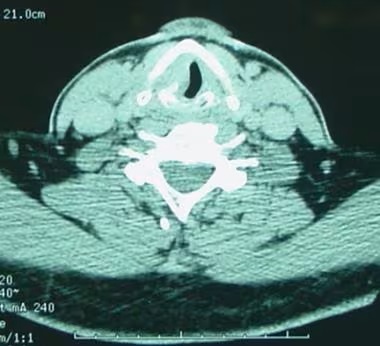Every year around 2400 people are diagnosed with cancer of the larynx. Fortunately, on a small fraction of these patients will need to have their larynx surgically removed with a laryngectomy. Treatment decisions after diagnosis have a crucial effect on progression of the disease.
Mr Amar Rajgor is a Registrar at Newcastle’s Freeman Hospital and a NIHR Doctoral Research Fellow in Ear Nose and Throat Surgery. He is carrying out research to improve the treatment of larynx cancer. Artificial Intelligence is being used to analyse scans such as CT scans. Cutting-edge software examines the images looking for patterns that cannot be seen by the naked eye and this sort of analysis of images is called radiomics.
Mr Rajgor said “Radiomics can be seen as a super-powered magnifying glass for medical images, like CT scans. It carefully examines every tiny detail, even the ones that are hard to see. By doing this, it can find patterns and irregularities that cannot be seen by a human or might otherwise be missed.”
The analysis can reveal markers that indicate the likely progression of the disease and provide better indicators than the conventional ones, such as age and the stage of the tumour.
Mr Rajgor added: “These developments are very exciting, as this research could play a big role in guiding treatment and delivering precision medicine in the future. It could ensure that patients get the right treatment for them, based on what their tumour looks like and how it behaves. I hope this will also help patients make more informed decisions about their treatment journey.
“Another positive is that this method does not change the patient pathway but enhances it, by analysing medical images in a way that cannot be done by a human. Currently, much of the information from scans is not being fully utilized, but this allows us to unlock its full potential.”
Mr Rajgor’s work has recently been published in the journal of Laryngology and Otology.
( With thanks to the Newcastle Chronicle )
